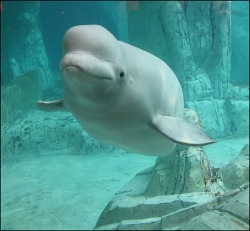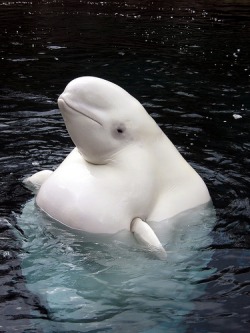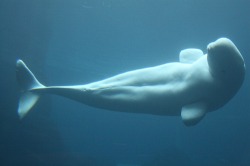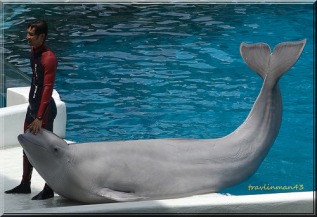 Beluga by Midnights Garden Beluga by Midnights Garden It is a pleasure for me to write this post, as I consider the Beluga Whale to be one of the most beautiful creatures on earth. Often called White Whales, the Belugas (Beluga meaning "White One" in Russian) are, for me, the closest a living thing can be to an Angel. They are very popular with, and have good relations with, the human race, and have even been known to save human lives on occasion. Its proper name is Delphinapterus leucas, the latter part meaning white, the former meaning "without fins", as the Beluga has no dorsal fin. This makes it easier for the animal to swim under the Arctic ice. The Beluga is about 13 to 20 feet (4 to 6.1m) long, and are smallish in whale standards. They weigh about 3,300 pounds (1500kg), with males being slightly larger than females. This makes them smaller than most whales. Another difference between the Beluga and other whales is the fact that their neck vertebrae are not fused. This allows them far greater mobility in the head and neck, and also more facial expressions. It is this which allows them to have that beautiful smile, for which they are known they are known and loved. The Beluga is also known for the varied sounds it makes, and has been given the name "Sea Canary" as a result. These sounds are so loud that they can even be heard above the surface of the water. They not only use a huge range of clicks, whistles, and clangs, but can also mimic many other sounds. This proliferation of diverse sounds allows for high levels of communication, and indeed the Beluga is a very sociable animal. You can hear some of their squeaks, clicks and calls here on the BBC Website.  Beluga Whale by jspad Beluga Whale by jspad They have a large melon dome on top of their heads, which makes it look as if they have an extremely large brain. This protuberance is malleable, and the Beluga can change the shape of its head by blowing air around its sinuses. It is thought to contain a very fine oil, which is used as a way to focus the sonar waves it produces to sense its surroundings. They usually swim in small groups called pods of between 2 - 25 whales, and will hunt and migrate together. The Arctic and sub-Arctic waters are the natural home of the Beluga, though fossils show that their territory expands and contracts with the extent of the Arctic Pack Ice. Belugas do sometimes migrate south into warmer waters, mainly in the summer months. The Beluga's habitat overlaps with that of its closest living relative, the Narwhal. Being a slow swimmer, about 2 - 6 mph (3 to 9 kph), Beluga are opportunistic feeders. They can reach a speed for about 14mph, but only in short bursts. They feed mainly on cephalopods and crustaceans, but also on worms living on the sea-floor. A typical Beluga dive lasts for a mere 3 - 5 minutes, but they can stay under for up to 20 minutes, and have been know to dive well over 1000 feet (300m) down. The main predators of the Beluga are Polar Bears and Orca. Orca, of course, will hunt them in the open ocean. Polar bears are able, when the Beluga become trapped in the Arctic Ice, to haul them out of the air holes as the Beluga desperately try to breathe.  Beluga Whale by Pocketwiley Beluga Whale by Pocketwiley The Beluga usually reproduces, once every three years, to one live calf at a time. The gestation period is 14 - 15 months. Interestingly, the calf is born a bluey-brown colour, turning grey after about a year, only changing to the more usual white after about 6 years. The baby Beluga is about 4 - 5 feet (1.2 - 1.5 m) long, and weighs about 180lbs (80kgs). For the first 2 years of its life, the baby Beluga relies on its mother for everything, and feeds exclusively on her fatty milk (28% fat). They reach maturity aged about 8 years. Below is a video of the birth of a beluga calf. Notice how it instinctively makes for the surface straight after coming out.  Marine Park, Beluga Whale by Travlinman43 Marine Park, Beluga Whale by Travlinman43 The Beluga has a long history with Humans, being one of the first whale species in captivity. Barnum's Museum in New York City held the first captive viewing of a Beluga in 1861. Since then, it has remained one of the most popular aquatic attractions around the world. The relation between Human and Beluga goes much further than this, however. There have been many reports of the whales' interventions when divers or swimmers get into trouble. One such story was the case of Free Diver Yang Yun, who was saved by a Beluga called Mila at Polar Land in northern China. Yun started to experience excruciating cramps, which left her unable to reach the surface to breathe. As Yun started to choke, Mila sensed her distress, and came to her aid, gripping her leg with her mouth, and gently driving her up to the surface. Yun said: “I began to choke and sank even lower and I thought that was it for me – I was dead. Until I felt this incredible force under me driving me to the surface.” Read the full article here. There's also a Beluga group on Flickr, which you can see here: Delphinapterus leucas (Beluga Whales). I'll leave you with a video of a playful Beluga blowing bubbles and catching them at an aquarium.
0 Comments
Your comment will be posted after it is approved.
Leave a Reply. |
MOST VIEWED POSTS
© James Edward Hughes 2013
 RSS Feed
RSS Feed





